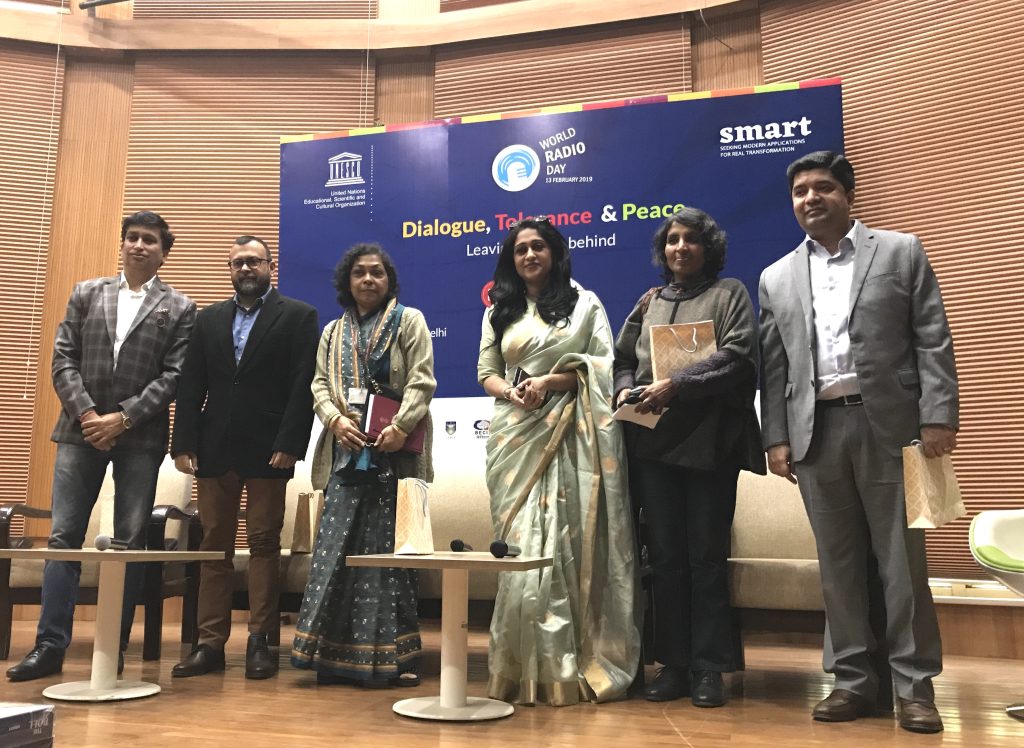The number of private commercial stations in India has exploded over the past decade. In this article, first published on AsiaRadioToday, we get a snapshot of the successes and challenges in India’s private radio industry. Music formats Nisha Narayanan, COO of Red FM said, “it’s a rare occasion when commercial and community stations are in the same room.” She commended the organisers of the conference for their industry wide approach. There are now hundreds of private FM stations on air across India after the government auctioned frequencies in major and middle level markets. Most of these stations are targeting mainstream popular music audiences. “When you pay so much for a licence you need to target a big audience and many of us are targeting the millennials. Licencing policy may need to be looked at if people want more variety in formats,” said Nisha, suggesting that the reserve price for auctions could be lowered to encourage more experimentation in formats that may not make as much money as mainstream Bollywood hit music. There are, however, many elements of differentiation between the networks: “When people talk about the sameness of formats, they are often talking about music, but there are more elements to our stations than that, RJs, promotions, campaigns… we do a lot of stuff but it doesn’t get reported. There is storytelling, reality radio, audio books, this is what brings in the differentiation.” My FM and Red FM, for example, are similar in music formats but different in the other areas, such as playing gold songs that are older than other stations which play contemporary Bollywood hits. Big FM is a station that does have a different music format, it plays electro music. Big FM’s CFO Asheesh Chaterjee explained: “We researched music and local languages. We found that there is an audience for music in languages other than Hindi, so we now play music in 17 languages across our stations in various parts of the country. The RJs also take up community issues and celebrate the heroes of the community.” Big FM recently changed its tag line and is launching some very big shows around it new positioning. The slogan, which means ‘let’s be open minded’ in English, reflects the station philosophy of picking up many social topics and looking at them in a deeper manner. “Radio has evolved from just being a music station to being a more engaged content supplier,” said Chaterjee. Anju Nigram from India’s Broadcasting Ministry confirmed that the ministry has noticed the changes, saying it is a positive indicator for how stations will eventually differentiate their formats. Rahul Namjoshi, the Head of Business at My FM explained his network’s differentiation: “Bollywood is important for us, but we also play film music in other languages and other music besides film music… My FM’s RJs are talking about many other topics beyond films and film music, we also cover sport, we do comedy and get involved with lots of local issues.” With 32 players in the FM Commercial sector, only the top six are making a profit according to Nisha Narayanan. “We have many stations which do not make profits, but we believe in the medium and we subsidise them from other profitable cities,” she said. The base price of an auction is Rupees 13 Crores (USD $190,000). “When we have to recoup that money there is no way we can get into other forms of music, because bollywood music is the most viable format for advertisers,” explained Nisha. “We tried just folk music, but we had to struggle.” Transmission platforms The BBC’s Sanjoy Majumder explained that his organisation is a public service not a commercial organisation. “Our association with the radio audience here in India dates back to the 1930s. We are a news and current affairs channel but we have a very varied range of content.” “Radio as a medium is both powerful and intimate. It is a very creative medium and its reach in India is phenomenal.” The BBC is only available on shortwave in India but still has a very loyal audience despite the fact that the shortwave band is not so well used now. Majumder made the point that radio is a very easy technology to access and use, but that the BBC is also expanding beyond traditional broadcast platforms. “For radio you don’t need bandwith, it is available for everyone… We hope we can reach audiences on new platforms as well as the traditional radio airwaves.” The BBC has launched a range of podcasts of internet to Indian audiences. Highly priced and restricted music copyright arrangements are also a barrier to stations streaming on multiple platforms. “We are tyring to get rights to play music on digital platforms, but the cost is debilitating and it keeps us off the digital platforms,” said Nisha. With more and more Indian listeners using smartphones there is a push to ensure that all phones sold in India include radio receivers (FM and Sigital Radio). The telcos are “promoting their own interests” because they want to earn more money by making listehners stream their audio, but “free radio should be available on all smartphones,” according to the panel. High cost of licences The high price of licences is an ongoing issue in India. “Licence fees are determined by the price at auction. High prices show that radio is a medium that is highly in demand,” said the Ministry’s Anju Nigram. In 2001 there were 21 private FM stations in India, now there are hundreds, with more licences still to be released. “Radio is a cheap medium, internet is not available to the common masses, so radio remains very important. It is portable and dynamic. With so many new stations in the larger cities there are more jobs being provided jobs for local talent,” she said. The group then widened its discussion beyond commercial radio to community radio: “Community radio really thrives on local talent, it gives voice to the voiceless and broadcasts in local dialects.” The ministry has undertaken to expand the number of community licences available in the next year. “For radio businesses to grow we need more regional players and there should be space for everyone in the spectrum, community and commercial,” said Nisha. Restrictions on news bulletins and sport Another ongoing issue in India is the requirement for private stations not to broadcast news bulletins unless they are sourced from the national broadcaster, All India Radio. Talk shows are allowed, but they must not have political content in them. Independent news bulletins are banned. “Indian radio is still ruled by draconian laws for newspapers that were made before radio was even invented,” said Nisha. All the commercial radio leaders were in favour of lifting the restrictions on news bulletins. The BBC’s Sanjoy Majumder belives the government and the regulator have seen news coverage on television get out of hand and are worried that the same could happen on radio if restrictions are relaxed, however, he says that clear self regulatory guidelines could solve the problem. Restrictions on live sporting coverage is also a problem, according to Asheesh Chaterjee: “Sports is a big category that is very restricted. Commentary is not allowed on private FM stations, we cannot tap into that to create our audience segments. Fortunately most of our content is designed to be platform agnostic, so we can try to monetise those platforms, but we are very restricted, while some tv channels are getting into everything.” Audience measurement There is no common currency across India to measure all of radio, so the industry is fragmented in terms of research and not consistent in its messages to advertisers. “We all have our own methods to measure our audience,” explained Rahul Namjoshi. “Radio is hyper-local, we do research for each city, in some area where there are students they like western music, in other areas there are other needs.” Panellists claimed that high cost is a factor in not using one single research provider, but the industry is trying to find a solution. “We are working on an industry wide mechanism for at least the top 25 markets.” All India Radio does its own research, which does survey private commercial audiences, but it is not freely available to the private players, so is not used outside of AIR. The BBC’s focus is to increase its younger female audience in various languages. “Millennials want to know how things happened, not just what happened… There is a massive vernacular audience in other languages other than English and Hindi.” AsiaRadioToday is a media partner of RadioDays Asia. The Radiodays Asia conference 27-28 August 2019 will give insights into the radio landscape across Asia and bring world leading speakers to Asia to share ideas and energy.


